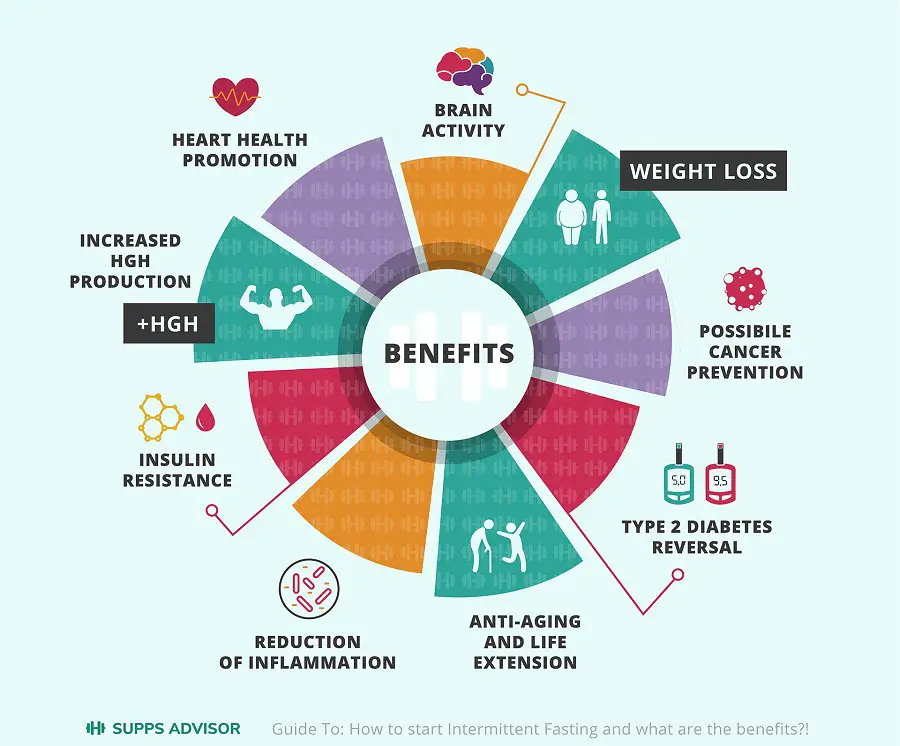This post may contain affiliate links. For more info, please read our full disclosure here
For decades, fasting has been practiced across different sections of everyday life. It has been used for spiritual, mental as well as dietary purposes. It has been shown to solve a variety of problems for us humans at least to some degree.
The basic concept of fasting is abstinence from food. Intermittent fasting is a kind of fasting that looks at the dietary side of things. Short for IF, it is a widespread practice a lot of people use today to lose weight, improve health and get in better shape overall.
Intermittent fasting and the keto diet are actually very compatible, like a power duo when combined right and can help you speed up weight loss, boost your energy or even break through a weight loss plateau.
This guide explains what IF is, how it works, and how to successfully use intermittent fasting on keto.
What is intermittent fasting (IF)

Intermittent fasting is a dietary approach that involves limiting all food intake to a specific time window and staying without any calorie containing food for the remaining time period.
So it basically consists of 2 periods;
- A fed state or period – this is the period of time window to which eating is limited to
- A fasting state or period – this is the period where you stay without calorie containing foods.
During the fasting period, you are only allowed to take thing with zero calories. But during eating hours, you are basically allowed to eat whatever you want. Taking anything containing calories ruins the whole concept of the “fast”
Basically, all eating is limited to a specific period of time while you have to “fast” during the remaining time period. The concept is to allow your body to be able to access your fat stores for energy, which is also what the keto diet helps you do.
Intermittent fasting is actually pretty easy to follow and also comes with a bunch of health benefits when you do it right.
Speaking of doing it right, there are different types and ways you can do intermittent fasting.
The different types of IF
There are different ways you can take advantage of intermittent fasting (IF). The fed and fasting periods could range from hours within a day to full days, depending on the kind of intermittent fasting you choose to practice.
Here are the most types of IF
1) Skipping meals: this is about the simplest form of IF and it’s something a lot of people do without even realising.As it implies, this involves skipping one meal of the day. It could be breakfast, lunch or dinner.
Most people prefer skipping either breakfast or lunch. The whole concept is to create an eating window during your meals by removing one of your 3 main meals for the day.
Remember, snacks count too so if you eat snacks when skipping meals, then you’re not doing IF.
2) A 24-hour eating window: this is the most common method of intermittent fasting practiced today. In this method, you basically divide a 24 hour period into a fasting and eating periods.
The fasting period is obviously larger compared to the feeding period. You may have seen or heard of words like 16/9 or 19/5 or 20/4. Those are used to refer to the fasting windows.
For example, 16/9 means you will abstain from taking food for 16 hours while you have to limit your eating window to 9 hours. Likewise, 19/5 means 19 hours of fasting and a 5 hour feeding period. 20/4 means 20 hours of fasting and a 4 hour feeding period.
3) Extended fasts: these are more or less full day fasts followed by hours or full day eating windows.
Basically, you are required to abstain from all foods containing calories during those days (some exceptions in some cases) while having hours or even full days of eating afterwards.
Whichever method you decide follow should depend on you and be based on what fits well with you. Please do not force it. Rather, let it come more naturally. It is way more effective and sustainable that way.
These are the 3 most common ways to do IF. But how does staying without food for a couple of hours a day boost weight loss and improve health? What’s the logic and science behind it?
Let’s find out.
How intermittent fasting works

Intermittent fasting isn’t just regular starvation. During regular starvation, your body senses a lack of food as in the case of farming and locks out your fat stores as a way to try to keep you alive. But intermittent fasting is quite different.
By limiting your food intake to a specific period of time window, you automatically eat less calories without even knowing. Unlike calorie restriction diets, you are less likely to lack nutrients as you can get enough of them during the eating period.
In the fasted state, your body needs to meet up its energy requirements. To do this, it turns to extra body fat for fuel and burns that fat for energy, similar to what the keto diet does. That is why it is used as a powerful weight loss tool.
And that is why combining intermittent fasting and keto the right way can be a really good thing for most people.
But that’s not all. IF has shown to cause some processes in the body to occur which in turn improves certain health markers like insulin sensitivity, muscle health and more. Here are some health benefits of intermittent fasting.
Health benefits of intermittent fasting

These are some of the health benefits associated with practicing Intermittent fasting (IF)
Weight loss
To lose weight, you need to be able to consume less calories than your body needs to maintain itself. Intermittent fasting makes this possible. When you eat to your during specific time windows, you consume less calories overall without noticing.
This is because your body can only handle a certain amount of food at a time. During the fasted state, your body meets its remaining energy needs by burning excess body fat for energy. This in turn leads to weight loss.
Insulin sensitivity
When blood glucose levels becomes way too high way too regularly, insulin resistance may soon come knocking. Naturally reducing and maintaining blood sugar levels is a way to improve insulin sensitivity in the body and also battle insulin resistance.
Intermittent fasting is said to be able to reduce blood sugar by 3 – 6%, which reduces insulin resistance and improves insulin sensitivity
Mental clarity
Intermittent fasting in a way, improves brain function and mental clarity. A particular study showed that fasting improved the expression of a brain hormone called BDNF which plays a part in brain function.
On the keto diet, you use ketones for fuel which are also good for the brain and reduces mental fogginess. Practicing intermittent fasting on keto, you can further boost your brain health and mental clarity.
Better physical performance and muscle health
IF is good for physical performance and muscle health. It may seem counterintuitive considering the fact that you’re actually going to be fasting in a way. Well, there are certain things that IF does to help improve performance and muscle health.
First of all, it causes a process called autophagy, meaning “self-eating”. Basically put, it is when your cell devours itself. I know it sounds weird and scary, but it’s actually a good thing for our weird human bodies.
Autophagy is how your body recycles bad or damaged cells. Damaged cells are recycled and replaced by new healthy cells, which improves muscle health and helps to prevent muscle loss.
If autophagy doesn’t happen and damaged cells are left as they are, they begin do die more quickly, leading to muscle loss. But thanks to the autophagy that recycles damaged and bad cells, you have healthier and better muscles.
IF helps to prevent and also minimize muscle loss when losing weight
Other health benefits of IF include
- Longevity and anti-aging
- May help prevent cancer
- Reduces inflammation
- May help protect against Alzheimer’s disease

These are the benefit that come with IF. But what happens when you combine IF and keto?
Intermittent fasting on keto – What it does
Here are a couple of ways you can benefit from doing intermittent fasting on a keto diet.
- Improved weight loss – IF combined with the ketogenic diet can help you boost fat loss and also help to break through a weight loss plateau. If you’re losing weight at a proper and normal rate, then no need to do IF. Just keep doing your thing.
However, if you’re experiencing a weight loss plateau, then IF can help you break through and drop off the last bunch of stubborn fat.
- Shortcut to ketosis – When you fast, your body utilises your fat stores for energy, which is also the goal of the keto diet; to burn fat for energy (Ketosis). Doing intermittent fasting on keto can give you the boost to help you reach ketosis quicker.
These are some of the things you can benefit from combining IF with keto dieting. Now then, here’s how you can do intermittent fasting on the keto diet.
How to do intermittent fasting on keto

Doing Intermittent fasting on the keto diet isn’t a brain racking activity. It’s actually very easy. Here’s how to get started with it.
Choose your fasting window
The first step to take when starting out intermittent fasting on the keto diet is to pick out your fasting window. This means choosing your fasting period (number of hours you will stay without food) and your feeding period (time period you’ll be eating).
The easiest to do is skipping meals like I said earlier. But the most common is the 16/8, which is a 24 hour plan with 16 hours of fasting and an 8-hour feeding period.
You can also try the 20/4 which involves 20 hours of fasting and a 4-hour feeding period. IF extended fasts are your thing, then feel free to give it a shot. Its best choose what you are most comfortable with and work your way up from there if you like.
For example, you can start with just skipping meals once in a while before you move on to something like 16/8. One good thing to note is that sleeping time counts as fasting time as well, so it definitely makes it easier.
One thing I advise is to not obsess over planning. Let the IF happen more freely and eat only when you feel hungry.
You’d be surprised at how well the appetite suppressing power of ketosis works well with IF.
Pay attention to your macros
Your macros are still important even if you are fasting. Not getting enough of them can affect you on the long run. For example, if you eat too little protein for a long time, you will begin to lose muscle mass.
Watch how I said “over a long time”. Not hitting your ratios for a day or 2 is ok and isn’t likely to cause any significant change. But you should still make sure you’re getting enough. The best way to define your macros is by using a keto calculator.
Here is a good keto calculator we recommend
Eat healthy keto foods
The last thing to remember is to keep it keto. Always lean towards real healthy foods. Not just for intermittent fasting but in general. They are richer in essential nutrients needed by your body.
These are the fundamentals you need to keep in mind when doing intermittent fasting on the ketogenic diet.
When intermittent fasting isn’t for you
Although intermittent fasting might seem like the magic bullet to combine with the ketogenic diet, there are certain groups of people that shouldn’t engage in IF.
This is because it can have certain effects on specific conditions that won’t apply to the average normal person.
Here are certain situations where you should not engage in IF
- Pregnancy – pregnant women should best abstain from IF. This is because the babies become more prone to nutrient deficiencies.
- Breastfeeding – also like pregnancy, IF can affect the quality of breast milk. If you are a breastfeeding mother, then that might not be the best time to practice IF.
- Diabetes – people with diabetes might need to be a little bit more cautious when doing IF. We recommend consulting your doctor before engaging in it
- Not feeling it – IF shouldn’t be a burden to you. If you’re not feeling it, don’t force it.
Summing it all up
Intermittent fasting has its benefits when done right and so does the ketogenic diet. Both work together to improve health and boost weight loss efforts along other benefits.
IF can help you get into ketosis quicker or even break through a weight loss plateau. Although remember that IF might not be ideal for everyone and isn’t a magic bullet.
If you have a medical condition like diabetes or are pregnant or breastfeeding, please consult your doctor first.
Overall Intermittent fasting on keto can have a lot of positive effect when done right and can improve the results you get on the ketogenic diet as well as on overall health.
If you enjoyed this guide, feel free to share it with your friends. Also check out our free keto resources and keto diet recommendations to help you easily reach your goals and succeed on ketogenic diet.
Keto Meal Plans That Make Fat Burning Easier
References
- Intermittent fasting, the science of going without – NCBI
- Intermittent fasting and metabolic health – NCBI
- Effects of short term fasting on longevity – NCBI
- Promoting Health and Longevity through Diet – NCBI
- Influence of Ramadan fasting on athletic performance – NCBI
- Muscle protein synthesis during recovery from aerobic exercise – NCBI
- Fasting and insulin resistance – NCBI
- Fasting and the expression of BDNF in rats study – NCBI

